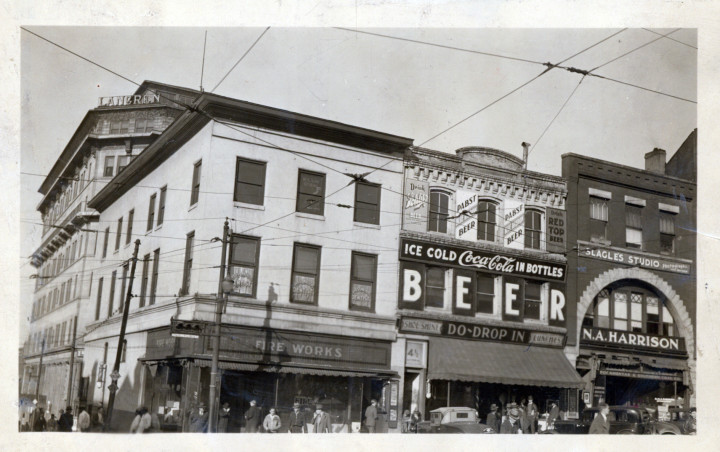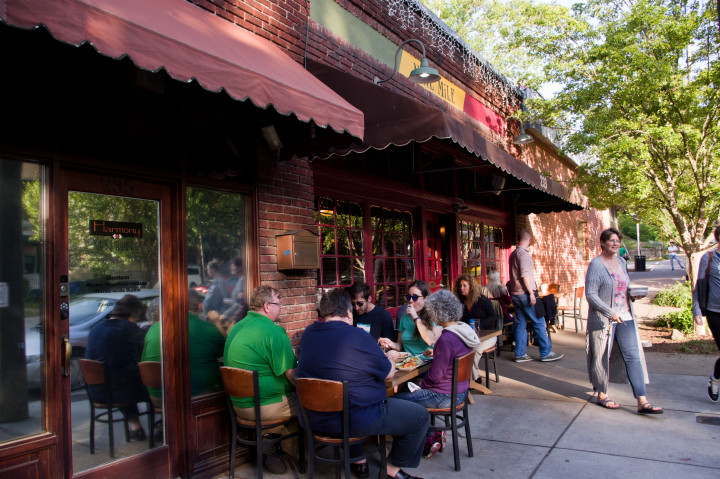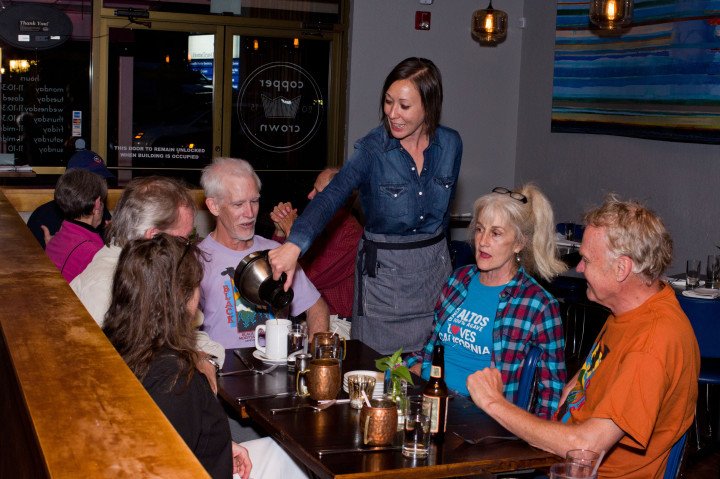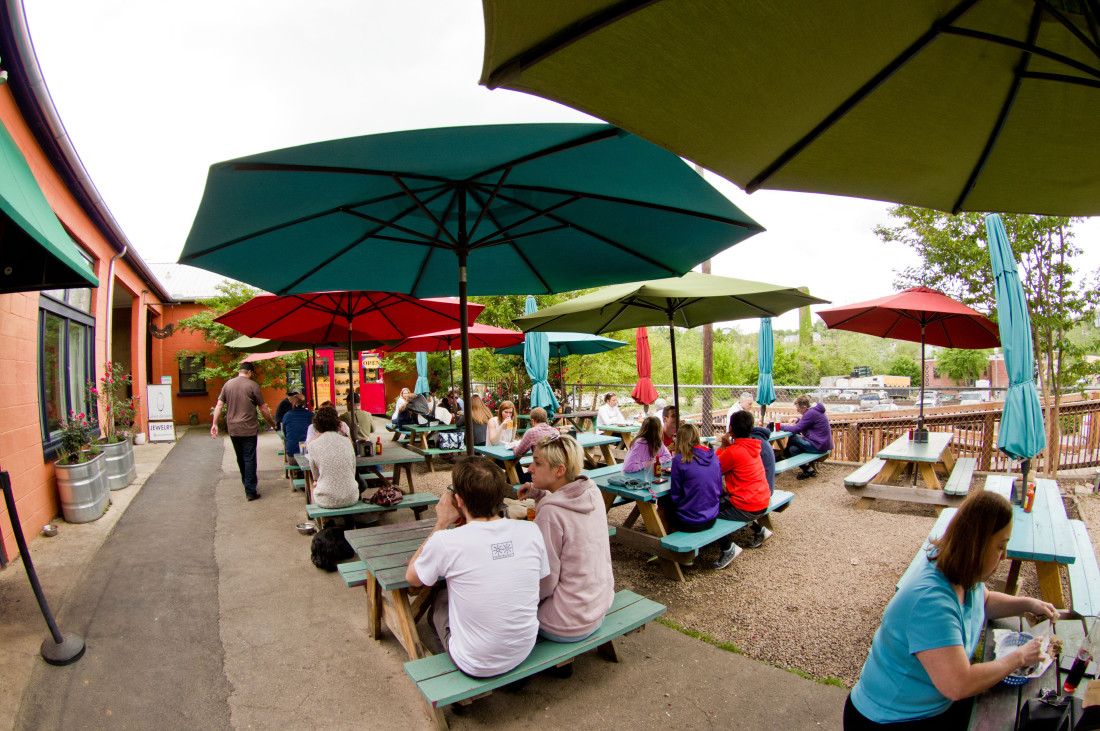From the “Land of the Sky” to today’s “Beer City” and “Foodtopia,” Asheville has seen its fair share of incarnations. For more than a century, the ebb and flow between hard times and periods of great prosperity have helped create a city that’s both resilient and brimming with possibilities. And those complex dynamics have been, and remain, inextricably bound up with the city’s food and drink scene.
“Pack Square was the social, economic and political hub of Western North Carolina,” remembers 88-year-old Asheville native Joe Bly. “My family used to go to the S&W when it was the greatest cafeteria on the planet. And the art deco inside is still in there, and it is gorgeous.” In the ’50s, “there were stores all the way around the square. There was Quality Bakery, Peterson’s Grill, there was a hardware store and a movie theater, and Pack Library was there,” the lifelong local resident recalls.
That period was far from the city’s high point, however. The Great Depression had taken a brutal toll on Asheville, and between 1929 and the 1970s, the city stagnated. The population stayed stuck at about 50,000 until the ’60s, and what tourism there was was largely limited to Biltmore Estate. That, of course, did little to bolster the local food scene.
The advent of urban renewal in the ’50s and ’60s sparked other major changes that rippled through the city’s fabric, particularly the African-American neighborhoods. On the South Slope, home to today’s flourishing beer scene, hundreds of black families were removed to what was supposed to be “temporary” public housing while their neighborhoods were restructured. In many cases, however, that simply never happened, and in the meantime, former small-business owners were reduced to earning wages in the limited opportunities available to them — or else relying on public assistance.

Celebrated local photographer Andrea Clark, notes Bly, “took thousands of photographs of Southside and Mountainside,” documenting community life both before and after urban renewal. A few of those photos formed the basis of “Twilight of a Neighborhood: Asheville’s East End, 1970,” a multifaceted project partly funded by the North Carolina Humanities Council. Bly, however, says, “When I asked her what she’d intended to call the book, had she chosen the title … she said, ‘I would have called it The Negro Removal and Redistribution of Downtown Asheville.’”
Ironically, urban renewal and the civil rights movement combined to sound a death knell to many black-owned restaurants and other businesses.
High tea on Wall Street
Meanwhile, the ’60s also saw major highway projects that devastated neighborhoods, displacing additional homeowners and vivisecting once-vibrant areas. The road construction triggered significant demographic shifts, as residents moved to outlying parts of west, east and south Asheville. Particularly in the latter two areas, farmland was being converted into burgeoning suburbs.
At this time, North Asheville was a thriving neighborhood for what Bly calls “the old money.” It had its own movie house, the Merimon Twin Theatre — which would eventually become Two Moons Brew-N-View and, later, Asheville Brewing Co. West Asheville had its own slew of diners, theaters and pool halls.
Meanwhile, the opening of the Asheville Mall in the early ’70s accelerated the trend. And with downtown’s population shrinking, major department stores like J.C. Penney and Sears — not to mention the beloved S&W Cafeteria — closed or relocated to Tunnel Road. In time, that left the city center a virtual ghost town, with few residents and limited business activity after the workday ended. Between 1970 and 1980, the city’s population actually dropped by 10 percent.
But these dramatic shifts also created opportunities, as people with more imagination than money took advantage of low rents to launch new eateries and other businesses.
Nancy Orban opened the High Tea Café on Wall Street in 1974. “When I first started, downtown was deader than a doornail,” she recalls. “That was right after all the big stores moved to the mall.” Having relocated from San Francisco, the adventurous young woman decided to take a chance on a quaint little city with a lot of empty buildings. “Rent was only $60, so you could really try anything. And it seemed safe to open up a restaurant,” she continues, because apart from The Mediterranean, “There really wasn’t much else.”
Pete Apostolopoulos, who took over The Mediterranean in 1975, remembers those days well. “Back in the mid-’70s and up to the early ’80s, you wouldn’t be caught dead downtown after 5 o’clock. Lexington Avenue had some beer joints, and it was a strip for the hookers,” he said in a 2014 interview with Xpress. “I remember, where the Green Sage is now, it was an X-rated peeping hole joint. And up on the square, there was one of those X-rated, put-the-quarter-in kind of places. It was getting bad. There wasn’t a tree downtown anywhere!”
Feet on the street
In 1976, Asheville finally retired its Depression-era debt. “They even burned the mortgage,” remembers Bly. “I went and saw them burn it at the Civic Center.” (The “mortgage” was actually a bond note.)
Around that time, the city entertained a proposal to convert a large swath of downtown into another mall. But a coalition of pioneering entrepreneurs and others smitten with a vision of a revitalized central business district rebelled. A referendum turned thumbs down on the mall plan, and in the wake of that, the city began looking at ways to capitalize on its core of historic structures. In the process, the seeds of today’s thriving downtown food scene were sown.
By 1979, strategies had been hatched to bring locals back downtown. They included funding festivals like Bele Chere, which drew thousands of people to the city center. “It wasn’t that there wasn’t much here back when Bele Chere started — it was just that people didn’t know about any of it,” says Orban. “But once they started the festival, people found out, and they came back all the time.”
In the ’80s, Bly retired from the post office while ramping up his long-running efforts to promote traditional music and dance via events like Shindig on the Green.
Meanwhile, the outlying areas had been taken over by chain stores that priced out many local businesses. “If you were a young man back in those days, you cruised up and down Tunnel Road between Shoney’s and Buck’s, and if you picked up a fight, you go over to Surfside on Patton and fight it out,” remembers Apostolopoulos, holding up his fists like a boxer.
Real food arrives
Despite those early efforts, the downtown food scene was still in its infancy.
“We moved here in ’81, and there wasn’t a whole hell of a lot here,” remembers longtime local restaurateur Vijay Shastri, whose various ventures have included The Flying Frog Café, the Frog Bar & Deli and The Latin Quarter. “In the late ’80s up through the ’90s, Tunnel Road really became chain central. Downtown, at that point, was mostly boarded up, and my parents bought our first place, The Windmill, in ’84, and then my sister and I opened Café Bombay in ’88.”
The Windmill served an intriguing combo of German and Indian cuisine, reflecting Shastri’s own mixed heritage. The unusual menu, however, seemed to satisfy the evolving Asheville palate. Originally located in a now-demolished building on Haywood Street, it eventually moved to the more heavily trafficked Tunnel Road.
“The big difference in Asheville, more so than its growth, is just the type of people that were here. That’s really what helped spur the restaurant culture in this town,” says Shastri. “Years ago, The Market Place was around, Flying Frog, even in the old days when 23 Page was still there, and we had Richmond Hill. We had, at that time, a group of folks that were quite well-traveled and relatively worldly for a little mountain town. But time takes its toll, and unfortunately, we lost a bunch of those folks all within basically eight to 10 years. You see the next generation come in, and it’s their kids and the younger generation.”
Growing popularity
But the downtown revival had a ripple effect: Between 1980 and 1990, Asheville’s population increased by 14 percent, and many of those newcomers washed ashore on the south side of town.
“Back then, there was no reason to come to South Asheville unless you lived out there,” says Asheville native Lance Carter, who spent 15 years working in management at McDonald’s while saving up money to open his own restaurant. Taking advantage of a growing suburban area, his Southside Café opened in 1990.
Hendersonville Road, remembers Carter, “was still under construction to be a five-lane highway. It was just me and the Black Forest Restaurant. Everything else was fast food. At that time, Airport Road wasn’t even developed at all. There was nowhere to shop, no attraction to draw people, so we had to rely on repeat business, and we had to keep our prices reasonable. We always tried to be cheaper than the Biltmore Forest Country Club. And we got a lot of their customers because we had better food for a little bit cheaper.”

Michael Parker moved to Asheville in the ’90s and began writing about food and wine for Rapid River Magazine. “A lot of things popped up in pretty rapid succession,” he recalls. “It seemed like everyone that hung out downtown back then was right around their 30s. Everyone was single; it was just fun. That was the worst part about Asheville growing so much: all my friends getting married, having kids and moving to South Asheville, where we’d never see them again. Why come to Asheville in the first place if you’re going to move to a f**king suburb?”
Even West Asheville, known to locals as “worst Asheville” for decades, began to blossom in the early 2000s with the opening of places like Westville Pub and Burgermeister’s. And by the time the Great Recession hit in 2008, Asheville was in the middle of another big growth spurt, with a population of nearly 70,000.
Shifting economics
When the recession hit, says Carter, “People were scared; they just didn’t want to spend their money. And then Biltmore Park opened — and that’s pretty much all chains — and we were still busy on the weekends, but people just stopped going out during the week.”
The Southside Café closed in 2010. The following year, Shastri’s Flying Frog Café and Frog Bar, downtown anchors for more than a decade, also closed.
“A lot of what I think has changed in this town closed the Frog,” says Shastri. “A huge amount of larger-spending corporate dollars are gone.” Volvo’s departure in 2009, he notes, took with it 228 jobs. “It’s virtually impossible, at a local restaurant, to replace a corporate dollar with a local dollar. They’ll spend $3 to every $1 a local will spend. How do you replace several hundred people who made $100,000 to $300,000 a year and had corporate entertainment budgets? With what? With a bearded brewer making $40,000 to $50,000? How do you replace the corporate dollars themselves when the locals don’t spend that same amount?”
But the recession also triggered a cultural sea change in how Americans eat, and it wasn’t just in Asheville: New York chefs like David Chang and Wylie Dufresne began creating affordable menus of high-quality food.
“You used to go out to eat for the overall experience,” says Carter, looking back to the days of fine dining. “I think people go out now just to socialize, and you don’t have to spend that kind of money to socialize anymore. You can go to a West Asheville bar, or go to 5 Walnut to meet someone and talk, and you don’t have to spend $60 a head. A lot of younger people don’t have that kind of disposable income, and that’s who’s here now.”
Shastri agrees. “It used to pretty much be that your higher-end restaurants were the only places to get any sort of decent real food,” he recalls. “Most everything else was little diners or cafés. Now there’s a ton of inexpensive real food.”
Paying the price
But what about those who say local restaurant prices are too high?
“I’m going to be brutally honest, because I don’t know a nicer way of putting it,” continues Shastri. “Anyone that thinks the food in this town is expensive doesn’t actually get out. I travel a lot: I get out, I see what’s out there. We don’t have a massive Indian community and whole neighborhoods that are owned by Indian families, so we aren’t going to have a dosa place and get a meal for $7. Things cost a little bit more because of the size: If you want your town to stay small, you’ve got to be willing to pay a little bit for it.”
The high cost of living puts a further damper on many folks’ ability to patronize high-end restaurants, Bly maintains. “There are people living together who don’t even know each other, because they have to. In 1944, my mother made $13 a week, and the lady who boarded with us made $18 a week. At that, we lived better than a lot of folks [in the service industry] are living here now. And we’d just pulled out of the Great Depression. … That’ll keep people from going out.”
Close to home
One thing just about everybody interviewed for this story seemed to agree on is how much Asheville has changed — and will continue to.
The city, notes Apostolopoulos, “has evolved. It’s amazing. I come downtown sometimes on the weekends, and I just look around and remember what it used to be like.”

And as downtown parking becomes an increasingly scarce commodity on weekends and rents continue to rise, it seems likely that more and more locals will revert to spending the bulk of their time in their own neighborhood.
To some extent, that seems to be happening already, as new restaurants open in formerly underserved areas and established local eateries retool or are bought up.
Expanding from its West Asheville base, Rocky’s Hot Chicken Shack opened a second location in South Asheville in 2014, and the East Village Grill recently acquired the former Black Forest Restaurant property (the Black Forest’s second location in Hendersonville is still open). In East Asheville, the chef from downtown’s Zambra has opened the Copper Crown, and in the evenings, Filo bakery and coffee shop morphs into the Post 70 Indulgence Bar. Meanwhile, Jonathan Robinson, a co-owner of The Admiral, which has been a key player in the West Asheville renaissance, has purchased the Tastee Diner — said to be the oldest continuously operating restaurant in Asheville.
For his part, Parker waxes nostalgic over what’s been lost, while also foreseeing a bright future for the area and its food culture. “I’m very pleased that Asheville is a successful city; I’m pleased that hundreds of thousands of people come here and have a good time,” he explains. “But part of that is that I was here before it got big, and I could enjoy things as they came in gradually. I got to enjoy that old Asheville crowd when everyone was single, and it was just fun.
“And I miss those times, but this is a city with a lot of value, and if you have a million-dollar idea in this town, there are a lot of resources here that will back you up.”




Fact check. Co-owner and dormant partner of The Admiral, Jonathan Robinson, has purchased Tastee Diner. This purchase does not represent The Admiral as a whole as it will remain its own entity.
Thank you so much for the clarification on that! We will adjust the wording in the online version of the story accordingly.
Thanks!!!!! We are all looking forward to seeing what Jobathan does with Tastee and can’t wait to support it!!!!
Absolutely no agenda here with throwing a quote out from the article- I read it twice and still am not sure how this makes sense for not toiling in the service industry, but in Shastri’s own words:
“if you want your town to stay small, you have to be willing to pay a little bit for it”.
Our fair city (the 11th largest in NC ) has not stayed small- it has exploded in terms of (out of town non locally owned) development/housing, chain stores, population and sheer number of places to eat.
Is that the new excuse for local landlords to use for potential renters for justifying Buncombe County’s highest rents in all 100 NC counties?
Can local workers therefore demand a livable wage with the same wording for tangible services provided or will cheap overseas labor substitute for local labor and comments about the ‘let the Almighty free market decide” type comments follow here?
Again- I ask only questions- enlighten me with answers.
Is this yet more rose colored glasses/Pollyanna journalism kneeling at the altar of the tourist dollar or is Asheville now suddenly a place to raise children who can afford a First World existence vs. only bringing them here to visit on vacation?
???
LOL,there is no free market at play as long as open borders and illegal immigration continue along with generous welfare and unemployment benefits that dis-incentivize work. It’s a stacked deck that your ideological views actually support. You want wages to rise? Make illegals actually illegal. Otherwise the flood of people from the south do more to lower wages and burden an already debt ridden nation than anything else lulz. And make government assistance hard. People want to live off of it then they need to be tightly controlled. It’s the incentive to get off of it.
HB2 has officially made it illegal for a county wide minimum wage hike. I think your argument is solid. Lulz is a bigot looking for a scapegoat. I’m surprised they didn’t blame the Jews.
My family moved to Asheville when I was 14 months old in 1955. I remember a lot of the early places this article mentioned. We operated and lived at the motel on Tunnel Road across from Blanton Wright’s Log cabins, when Tunnel Road was a two lane road. Now I am 68 years old and my memories of Asheville in the good ole days are fleeting. Thank you for helping me relive some of them with your coverage of eateries. Nothing better than Woolworth’s cheesecake!!